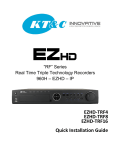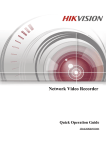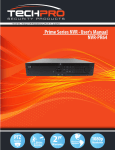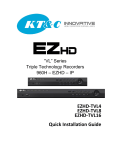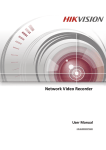Download Network Video Recorder - Surveillance
Transcript
Network Video Recorder Quick Start Guide Quick Start Guide of Network Video Recorder TABLE OF CONTENTS NVR Installation .............................................................................................................................................. 6 Hard Disk Installation ..................................................................................................................................... 6 Front Panel ..................................................................................................................................................... 10 Rear Panel ...................................................................................................................................................... 14 Peripheral Connections ................................................................................................................................. 16 Wiring of Alarm Input .............................................................................................................................. 16 Wiring of Alarm Output ........................................................................................................................... 16 Using of Alarm Connectors ...................................................................................................................... 16 Controller Connection .............................................................................................................................. 17 HDD Storage Calculation Chart ................................................................................................................... 18 Menu Operation ............................................................................................................................................. 19 Menu Structure......................................................................................................................................... 19 Startup and Shutdown .............................................................................................................................. 19 Setting the Admin Password .................................................................................................................... 20 Login and Logout ..................................................................................................................................... 21 User Login ....................................................................................................................................... 21 User Logout ..................................................................................................................................... 21 Live View ................................................................................................................................................. 22 Right-click Menu ..................................................................................................................................... 22 Adding IP Cameras .................................................................................................................................. 23 One-touch RAID Configuration ............................................................................................................... 25 Recording ................................................................................................................................................. 26 Instant Recording ............................................................................................................................. 27 All-day Recording ............................................................................................................................ 27 Playback ................................................................................................................................................... 27 Backup ..................................................................................................................................................... 28 VCA Detection ......................................................................................................................................... 29 VCA Search ............................................................................................................................................. 30 Accessing by Web Browser ............................................................................................................................ 31 Logging In................................................................................................................................................ 31 Live View ................................................................................................................................................. 32 Recording ................................................................................................................................................. 33 Playback ................................................................................................................................................... 34 1 Quick Start Guide of Network Video Recorder Quick Start Guide About this Manual This Manual is applicable to Network Video Recorder (NVR). The Manual includes instructions for using and managing the product. Pictures, charts, images and all other information hereinafter are for description and explanation only. The information contained in the Manual is subject to change, without notice, due to firmware updates or other reasons. Please find the latest version in the company website. Please use this user manual under the guidance of professionals. Legal Disclaimer TO THE MAXIMUM EXTENT PERMITTED BY APPLICABLE LAW, THE PRODUCT DESCRIBED, WITH ITS HARDWARE, SOFTWARE AND FIRMWARE, IS PROVIDED “AS IS”, WITH ALL FAULTS AND ERRORS, AND OUR COMPANY MAKES NO WARRANTIES, EXPRESS OR IMPLIED, INCLUDING WITHOUT LIMITATION, MERCHANTABILITY, SATISFACTORY QUALITY, FITNESS FOR A PARTICULAR PURPOSE, AND NON-INFRINGEMENT OF THIRD PARTY. IN NO EVENT WILL OUR COMPANY, ITS DIRECTORS, OFFICERS, EMPLOYEES, OR AGENTS BE LIABLE TO YOU FOR ANY SPECIAL, CONSEQUENTIAL, INCIDENTAL, OR INDIRECT DAMAGES, INCLUDING, AMONG OTHERS, DAMAGES FOR LOSS OF BUSINESS PROFITS, BUSINESS INTERRUPTION, OR LOSS OF DATA OR DOCUMENTATION, IN CONNECTION WITH THE USE OF THIS PRODUCT, EVEN IF OUR COMPANY HAS BEEN ADVISED OF THE POSSIBILITY OF SUCH DAMAGES. REGARDING TO THE PRODUCT WITH INTERNET ACCESS, THE USE OF PRODUCT SHALL BE WHOLLY AT YOUR OWN RISKS. OUR COMPANY SHALL NOT TAKE ANY RESPONSIBILITES FOR ABNORMAL OPERATION, PRIVACY LEAKAGE OR OTHER DAMAGES RESULTING FROM CYBER ATTACK, HACKER ATTACK, VIRUS INSPECTION, OR OTHER INTERNET SECURITY RISKS; HOWEVER, OUR COMPANY WILL PROVIDE TIMELY TECHNICAL SUPPORT IF REQUIRED. SURVEILLANCE LAWS VARY BY JURISDICTION. PLEASE CHECK ALL RELEVANT LAWS IN YOUR JURISDICTION BEFORE USING THIS PRODUCT IN ORDER TO ENSURE THAT YOUR USE CONFORMS THE APPLICABLE LAW. OUR COMPANY SHALL NOT BE LIABLE IN THE EVENT THAT THIS PRODUCT IS USED WITH ILLEGITIMATE PURPOSES. IN THE EVENT OF ANY CONFLICTS BETWEEN THIS MANUAL AND THE APPLICABLE LAW, THE LATER PREVAILS 2 Quick Start Guide of Network Video Recorder Regulatory Information FCC Information FCC compliance: This equipment has been tested and found to comply with the limits for a digital device, pursuant to part 15 of the FCC Rules. These limits are designed to provide reasonable protection against harmful interference when the equipment is operated in a commercial environment. This equipment generates, uses, and can radiate radio frequency energy and, if not installed and used in accordance with the instruction manual, may cause harmful interference to radio communications. Operation of this equipment in a residential area is likely to cause harmful interference in which case the user will be required to correct the interference at his own expense. FCC Conditions This device complies with part 15 of the FCC Rules. Operation is subject to the following two conditions: 1. This device may not cause harmful interference. 2. This device must accept any interference received, including interference that may cause undesired operation. EU Conformity Statement This product and - if applicable - the supplied accessories too are marked with "CE" and comply therefore with the applicable harmonized European standards listed under the EMC Directive 2004/108/EC, the RoHS Directive 2011/65/EU. 2012/19/EU (WEEE directive): Products marked with this symbol cannot be disposed of as unsorted municipal waste in the European Union. For proper recycling, return this product to your local supplier upon the purchase of equivalent new equipment, or dispose of it at designated collection points. For more information see: www.recyclethis.info 2006/66/EC (battery directive): This product contains a battery that cannot be disposed of as unsorted municipal waste in the European Union. See the product documentation for specific battery information. The battery is marked with this symbol, which may include lettering to indicate cadmium (Cd), lead (Pb), or mercury (Hg). For proper recycling, return the battery to your supplier or to a designated collection point. For more information see: www.recyclethis.info Industry Canada ICES-003 Compliance This device meets the CAN ICES-3 (B)/NMB-3(B) standards requirements. 3 Quick Start Guide of Network Video Recorder Safety Instruction These instructions are intended to ensure that user can use the product correctly to avoid danger or property loss. The precaution measure is divided into “Warnings” and “Cautions” Warnings: Serious injury or death may occur if any of the warnings are neglected. Cautions: Injury or equipment damage may occur if any of the cautions are neglected. Warnings Follow these Cautions Follow to these safeguards to prevent serious precautions prevent injury or death. potential injury or material damage. Warnings ● Proper configuration of all passwords and other security settings is the responsibility of the installer and/or end-user. ● In the use of the product, you must be in strict compliance with the electrical safety regulations of the nation and region. Please refer to technical specifications for detailed information. ● Input voltage should meet both the SELV (Safety Extra Low Voltage) and the Limited Power Source with 100~240 VAC or 12 VDC according to the IEC60950-1 standard. Please refer to technical specifications for detailed information. ● Do not connect several devices to one power adapter as adapter overload may cause over-heating or a fire hazard. ● Please make sure that the plug is firmly connected to the power socket. ● If smoke, odor or noise rise from the device, turn off the power at once and unplug the power cable, and then please contact the service center. 4 Quick Start Guide of Network Video Recorder Preventive and Cautionary Tips Before connecting and operating your device, please be advised of the following tips: • • • • • Ensure unit is installed in a well-ventilated, dust-free environment. Unit is designed for indoor use only. Keep all liquids away from the device. Ensure environmental conditions meet factory specifications. Ensure unit is properly secured to a rack or shelf. Major shocks or jolts to the unit as a result of dropping it may cause damage to the sensitive electronics within the unit. • • • • Use the device in conjunction with an UPS if possible. Power down the unit before connecting and disconnecting accessories and peripherals. A factory recommended HDD should be used for this device. Improper use or replacement of the battery may result in hazard of explosion. Replace with the same or equivalent type only. Dispose of used batteries according to the instructions provided by the battery manufacturer. 5 Quick Start Guide of Network Video Recorder Thank you for purchasing our product. If there is any question or request, please do not hesitate to contact dealer. NVR Installation During the installation of the NVR: 1. 2. 3. 4. 5. 6. 7. 8. Use brackets for rack mounting. Ensure there is ample room for audio and video cables. When routing cables, ensure that the bend radius of the cables are no less than five times than its diameter. Connect the alarm cable. Allow at least 2cm (≈0.75-inch) of space between racks mounted devices. Ensure the NVR is grounded. Environmental temperature should be within the range of -10 ºC ~ 55 ºC, 14ºF ~ 131ºF. Environmental humidity should be within the range of 10% ~ 90%. Hard Disk Installation Before you start: Before installing a hard disk drive (HDD), please make sure the power is disconnected from the DVR. A factory recommended HDD should be used for this installation. Up to 8 SATA hard disks can be installed. Tools Required: Screwdriver. As the installation steps of HDD are similar among different models, here we take the steps of certain series as examples. HDD Installation (A) Steps: 1. Fasten the hard disk mounting handle to the hard disk with screws. 2. Insert the key and turn in clockwise direction to open the panel lock. 6 Quick Start Guide of Network Video Recorder 3. Press the buttons on the panel of two sides and open the front panel. 4. Insert the hard disk along the slot until it is placed into position. 5. Repeat the above steps to install other hard disks onto the NVR. After having finished the installation of all hard disks, close the front panel and lock it with the key again. HDD Installation (B) Steps: 1. Remove the cover from the NVR by unfastening the screws on the back and side. 7 Quick Start Guide of Network Video Recorder 2. Install the HDD in the HDD rack using the provided screws. Fasten the screws on the button to fix the HDD. 3. Connect one end of the data cable to the motherboard of NVR and the other end to the HDD. 4. Connect the power cable to the HDD. 5. Re-install the cover of the NVR and fasten screws. HDD Installation (C) Steps: 1. Remove the cover from the NVR by unfastening the screws on the rear and side panel. 8 Quick Start Guide of Network Video Recorder 2. Connect one end of the data cable to the motherboard of NVR and the other end to the HDD. 3. Connect the power cable to the HDD. 4. Place the HDD on the bottom of the device and then fasten the screws on the bottom to fix the HDD. 9 Quick Start Guide of Network Video Recorder Front Panel Front Panel 1 No. Name Function Description 1 POWER ON/OFF 2 IR Receiver Power on/off switch. Receiver for IR remote ALARM READY Turns red when a sensor alarm is detected. Ready LED is normally blue, indicating that the device is functioning properly. Turns blue when device is controlled by an IR remote. STATUS Turns red when controlled by a keyboard and purple when IR remote and keyboard is used at the same time. 3 Status HDD Indicators MODEM TX/RX Flashes red when data is being read from or written to HDD. Reserved for future usage. Flashes blue when network connection is functioning properly. Guard LED turns blue when the device is in armed status; at this time, an alarm is enabled when an event is detected. GUARD The LED turns off when the device is unarmed. The arm/disarm status can be changed by pressing and holding on the ESC button for more than 3 seconds in live view mode. 4 DVD-R/W Slot for DVD-R/W. The DIRECTION buttons are used to navigate between different fields and items in menus. In the Playback mode, the Up and Down button is used to speed up and slow down recorded video. The Left and Right button DIRECTION will select the next and previous record files. In Live View mode, these buttons can be used to cycle through 5 Control channels. Buttons In PTZ control mode, it can control the movement of the PTZ camera. The ENTER button is used to confirm selection in any of the menu modes. ENTER It can also be used to tick checkbox fields. In Playback mode, it can be used to play or pause the video. In single-frame Playback mode, pressing the button will advance 10 Quick Start Guide of Network Video Recorder No. Name Function Description the video by a single frame. In Auto-switch mode, it can be used to stop /start auto switch. 6 USB Interfaces 7 Front Panel Lock ESC Universal Serial Bus (USB) ports for additional devices such as USB mouse and USB Hard Disk Drive (HDD). You can lock or unlock the panel by the key. Back to the previous menu. Press for Arming/disarming the device in Live View mode. Enter the Manual Record setting menu. REC/SHOT In PTZ control settings, press the button and then you can call a PTZ preset by pressing Numeric button. It is also used to turn audio on/off in the Playback mode. PLAY/AUTO ZOOM+ The button is used to enter the Playback mode. It is also used to auto scan in the PTZ Control menu. Zoom in the PTZ camera in the PTZ Control setting. Adjust focus in the PTZ Control menu. A/FOCUS+ It is also used to switch between input methods (upper and lowercase alphabet, symbols and numeric input). Edit text fields. When editing text fields, it will also function as a Backspace button to delete the character in front of the cursor. On checkbox fields, pressing the button will tick the checkbox. EDIT/IRIS+ In PTZ Control mode, the button adjusts the iris of the camera. In Playback mode, it can be used to generate video clips for backup. Enter/exit the folder of USB device and eSATA HDD. 8 Composite Keys MAIN/SPOT/ZOO Switch between main and spot output. M- In PTZ Control mode, it can be used to zoom out the image. Select all items on the list when used in a list field. In PTZ Control mode, it will turn on/off PTZ light (if F1/ LIGHT applicable). In Playback mode, it is used to switch between play and reverse play. Cycle through tab pages. F2/ AUX In synchronous playback mode, it is used to switch between channels. Press the button will help you return to the Main menu (after successful login). Press and hold the button for 5 seconds will turn off audible key MENU/WIPER beep. In PTZ Control mode, the MENU/WIPER button will start wiper (if applicable). In Playback mode, it is used to show/hide the control interface. Switch between single screen and multi-screen mode. PREV/FOCUS- In PTZ Control mode, it is used to adjust the focus in conjunction with the A/FOCUS+ button. PTZ/IRIS- Enter the PTZ Control mode. In the PTZ Control mode, it is used to adjust the iris of the PTZ 11 Quick Start Guide of Network Video Recorder No. Name Function Description camera. Switch to the corresponding channel in Live view or PTZ Control mode. Input numbers and characters in Edit mode. 9 Alphanumeric Buttons Switch between different channels in Playback mode. The light of the button is blue when the corresponding channel is recording; it is red when the channel is in network transmission status; it is pink when the channel is recording and transmitting. Move the active selection in a menu. It will move the selection up and down. In Live View mode, it can be used to cycle through different channels. 10 JOG SHUTTLE Control In the Playback mode: For some series, the ring is used to jump 30s forward/backward in video files. In PTZ control mode, it can control the movement of the PTZ camera. 11 SLOW DOWN/SPEED UP Slow down/speed up in playback mode. Front Panel 2 No. 1 2 3 4 5 6 Name POWER ON/OFF USB Interface IR Receiver POWER READY STATUS ALARM HDD Tx/Rx DVD-ROM DIRECTION Function Description Power on/off switch. Connect to USB mouse or USB flash memory. Receiver for IR remote control. devices. Power indicator lights in green when DVR is powered up. Ready indicator is normally green, indicating that the DVR is functioning properly. Indicator turns green when DVR is controlled by an IR remote control with the address from 1~254; Indicator turns red when the SHIFT button is used; Indicator does not light when the DVR is controlled by a keyboard or by the IR remote control with the address of 255; Indicator turns green when the DVR is controlled by IR remote control (with the address from 1~254) and keyboard at the same time , and the SHIFT button is not used; Indicator turns orange : (a) when the DVR is controlled by IR remote control (with the address from 1~254) and keyboard at the same time and the SHIFT button is used as well; (b) when the DVR is controlled by IR remote control (with the address from 1~254) and the SHIFT button is used. Alarm indicator turns red when a sensor alarm is detected. HDD indicator blinks in red when data is being read from or written to HDD. TX/RX indictor blinks in green when network connection is functioning properly. Slot for DVD-ROM. The DIRECTION buttons are used to navigate between different fields and items in 12 Quick Start Guide of Network Video Recorder ENTER SHIFT 1/MENU 2ABC/F1 3DEF/F2 4GHI/ESC 7 5JKL/EDIT 6MNO/PLAY 7PQRS/REC 8TUV/PTZ 9WXYZ/PREV 0/A 8 JOG SHUTTLE Control menus. In Playback mode, the Up and Down button is used to speed up and slow down recorded video. In All-day Playback mode, the Left/Right button can be used to select the recorded video of next/previous day; in Playback by Normal Video Search, the Left/Right button can be used to select the next/previous recorded file. In Live View mode, the directional buttons can be used to cycle through channels. In PTZ control mode, it can control the movement of the PTZ camera. Confirm selection in any of the menu modes. It can also be used to tick checkbox fields. In Playback mode, it can be used to play or pause the video. In Single-frame Playback mode, pressing the ENTER button will advance the video by a single frame. In Auto-switch mode, it can be used to stop /start auto switch. Switch of compound keys between the numeric/letter input and functional control. Enter numeral “1”; Access the main menu interface. Enter numeral “2”; Enter letters “ABC”; The F1 button can be used to select all items on the list; In PTZ Control mode, the F1 button can be used to zoom out (zoom-) the PTZ camera; In live view or playback mode, the F1 button can be used to switch between main and spot video output. Enter numeral “3”; Enter letters “DEF”; In PTZ Control mode, the F1 button can be used to zoom in (zoom+) the PTZ camera; The F2 button can be used to cycle through tab pages. Enter numeral “4”; Enter letters “GHI”; Exit and back to the previous menu. Enter numeral “5”; Enter letters “JKL”; Delete characters before cursor; Select the checkbox and ON/OFF switch; Start/stop record clipping in playback. Enter numeral “6”; Enter letters “MNO”; In Playback mode, it is used for direct access to playback interface. Enter numeral “7”; Enter letters “PQRS”; Manual record, for direct access to manual record interface; manually enable/disable record. Enter numeral “8”; Enter letters “TUV”; Access PTZ control interface. Enter numeral “9”; Enter letters “WXYZ”; Multi-camera display in live view; In Playback mode or MenuPlaybackTag playback interface, this button can be used to delete the selected tag. Enter numeral “0”; Switch between input methods (upper and lowercase alphabet, symbols and numeric input). In Playback mode, this button can be used to add the default tag. Move the active selection in a menu. The inner ring will move the selection up and down; the outer ring will move it left and right. In Playback mode, the inner ring is used to jump 30s forward/backward in video files. The outer ring can be used to speed up/slow down the video. In Live View mode, it can be used to cycle through different channels. In PTZ control mode, in can control the movement of the PTZ camera. 13 Quick Start Guide of Network Video Recorder Rear Panel The rear panel vaires according to different models. Please refer to the actual product. The following figure is for reference only. 32ch/64ch 4ch/8ch/16ch without POE 8ch with 8 POE interface 16ch/32ch with 16 POE interface No. Item Description 1 VIDEO OUT BNC connector for video output. 2 CVBS AUDIO OUT BNC connector for audio output. This connector is synchronized with CVBS video output. VGA AUDIO OUT BNC connector for audio output. This connector is synchronized with VGA video output. 3 LINE IN BNC connector for audio input. 4 RS-232 Interface Connector for RS-232 devices. 5 VGA DB9 connector for VGA output. Display local video output and menu. 14 Quick Start Guide of Network Video Recorder No. Item Description 6 HDMI HDMI video output connector. 7 eSATA Connects external SATA HDD, CD/DVD-RW. 8 LAN Interface 1 network interface provided for 1.5U chassis series and 2 network interfaces for 2U chassis series. 9 Termination Switch RS-485 termination switch. Up position is not terminated. Down position is terminated with 120Ω resistance. RS-485 Interface Connector for RS-485 devices. T+ and T- pins connect to R+ and Rpins of PTZ receiver respectively. D+, D- pin connects to Ta, Tb pin of controller. For cascading devices, 10 Controller Port the first NVR’s D+, D- pin should be connected with the D+, D- pin of the next NVR. ALARM IN Connector for alarm input. ALARM OUT Connector for alarm output. 11 GROUND Ground(needs to be connected when NVR starts up). 12 AC 100V ~ 240V AC 100V ~ 240V power supply. 13 POWER Switch for turning on/off the device. 14 USB interface Universal Serial Bus (USB) ports for additional devices such as USB mouse and USB Hard Disk Drive (HDD). 15 Network Interfaces with PoE function Network interfaces for the cameras and to provide power over Ethernet. The RS-485 interface and termination switch of the device are reserved for future use. 15 Quick Start Guide of Network Video Recorder Peripheral Connections Wiring of Alarm Input The alarm input is an open/closed relay. To connect the alarm input to the device, use the following diagram. If the alarm input is not an open/close relay, please connect an external relay between the alarm input and the device. Wiring of Alarm Output To connect to an alarm output (AC or DC load), use the following diagram: DC Load Connection Diagram AC Load Connection Diagram For DC load, the jumpers can be used within the limit of 12V/1A safely. To connect an AC load, jumpers should be left open (you must remove the jumper on the motherboard in the NVR). Use an external relay for safety (as shown in the figure above). There are 4 jumpers (JP1, JP2, JP3, and JP4) on the motherboard, each corresponding with one alarm output. By default, jumpers are connected. To connect an AC load, jumpers should be removed. Example: If you connect an AC load to the alarm output 3 of the NVR, then you must remove the JP 3. Using of Alarm Connectors To connect alarm devices to the NVR: 1. Disconnect pluggable block from the ALARM IN /ALARM OUT terminal block. 2. Unfasten stop screws from the pluggable block, insert signal cables into slots and fasten stop screws. Ensure signal cables are in tight. 3. Connect pluggable block back into terminal block. 16 Quick Start Guide of Network Video Recorder Controller Connection To connect a controller to the NVR: 1. Disconnect pluggable block from the KB terminal block. 2. Unfasten stop screws from the KB D+, D- pluggable block, insert signal cables into slots and fasten stop screws. Ensure signal cables are in tight. 3. Connect Ta on controller to D+ on terminal block and Tb on controller to D- on terminal block. Fasten stop screws. 4. Connect pluggable block back into terminal block. Make sure both the controller and NVR are grounded. 17 Quick Start Guide of Network Video Recorder HDD Storage Calculation Chart The following chart shows an estimation of storage space used based on recording at one channel for an hour at a fixed bit rate. Bit Rate 96K 128K 160K 192K 224K 256K 320K 384K 448K 512K 640K 768K 896K 1024K 1280K 1536K 1792K 2048K Storage Used 42M 56M 70M 84M 98M 112M 140M 168M 196M 225M 281M 337M 393M 450M 562M 675M 787M 900M 4096K 1.8G 8192K 3.6G 16384K 7.2G Please note that supplied values for storage space used is just for reference. The storage values in the chart are estimated by formulas and may have some deviation from actual value. 18 Quick Start Guide of Network Video Recorder Menu Operation Menu Structure Refer to the following figure for the menu structure: Menu Playback Export VCA Search Manual HDD Record Camera Configuration Maintenance Shutdown Normal Normal Behavior Search Record General Schedule Camera General System Info Logout Event Event Face Search Continuous Capture Advanced Parameters OSD Network Log Information Shutdown Tag Picture People Counting Alarm Advanced Image Alarm Import/ Export Reboot Holiday PTZ RS-232 Upgrade Motion Live View Default External File Privacy Mask Exceptions Net Detect Picture Video Tampering User HDD Detect Video Loss Hot Spare Smart Heat Map Sub-periods VCA The menu structure may vary according to different models. Startup and Shutdown Proper startup and shutdown procedures are crucial to expanding the life of the NVR. To start your NVR: 1. Check the power supply is plugged into an electrical outlet. It is HIGHLY recommended that an Uninterruptible Power Supply (UPS) be used in conjunction with the device. The Power button on the front panel should be red, indicating the device gets the power supply. 2. Press the POWER button on the front panel. The Power LED should turn blue or green. The unit will begin to start. After the device starting up, the wizard will guide you through the initial settings, including modifying password, date and time settings, network settings, HDD initializing, and recording. To shut down the NVR: 1. Enter the Shutdown menu. Menu > Shutdown 19 Quick Start Guide of Network Video Recorder 2. Select the Shutdown button. 3. Click the Yes button. Setting the Admin Password Purpose: For the first-time access, you need to activate the device by setting an admin password. No operation is allowed before activation. You can also activate the device via Web Browser, SADP or Client Software. Steps: 1. Input the same password in the text field of Create New Password and Confirm New Password. STRONG PASSWORD RECOMMENDED– We highly recommend you create a strong password of your own choosing (using a minimum of 8 characters, including upper case letters, lower case letters, numbers, and special characters) in order to increase the security of your product. And we recommend you reset your password regularly, especially in the high security system, resetting the password monthly or weekly can better protect your product. 2. Click OK to save the password and activate the device. For the old version device, if you update it to the new version, the following dialog box will pop up once the device starts up. You can click YES and follow the wizard to set a strong password. 20 Quick Start Guide of Network Video Recorder Login and Logout User Login Purpose: If NVR has logged out, you must login the device before operating the menu and other functions. Steps: 1. Select the User Name in the dropdown list. 2. Input Password. 3. Click OK to log in. In the Login dialog box, if you have entered the wrong password for 7 times, the current user account will be locked for 60 seconds. User Logout Purpose: After logging out, the monitor turns to the live view mode and if you want to perform some operation, you need to enter user name and password log in again. Steps: 1. Enter the Shutdown menu. Menu > Shutdown 21 Quick Start Guide of Network Video Recorder 2. Click Logout. After you have logged out the system, menu operation on the screen is invalid. It is required to input a user name and password to unlock the system. Live View Some icons are provided on screen in Live View mode to indicate different camera status. These icons include: Live View Icons In the live view mode, there are icons at the upper-right corner of the screen for each channel, showing the status of the record and alarm in the channel, so that you can find problems as soon as possible. Alarm (video loss, tampering, motion detection, VCA or sensor alarm) Record (manual record, continuous record, motion detection, VCA or alarm triggered record) Alarm & Record Event/Exception (event and exception information, appears at the lower-left corner of the screen.) Right-click Menu In live view mode, you can right click on the screen to access the following menu: Name Description Common Menu Quick access to the sub-menus which you frequently visit. Up to 5 sub-menu 22 Quick Start Guide of Network Video Recorder Name Description options are supported. Enter the main menu of the system by right clicking the mouse. Menu Switch to the single full screen by choosing channel number from the dropdown Single Screen list. Multi-screen Adjust the screen layout by choosing from the dropdown list. Previous Screen Switch to the previous screen. Next Screen Switch to the next screen. Start/Stop Auto-switch Enable/disable the auto-switch of the screens. Start Recording Start continuous recording or motion detection recording of all channels. Add IP Camera Enter the IP Camera Management interface, and manage the cameras. Enter the playback interface and start playing back the video of the selected Playback channel immediately. Four modes of output supported, including Standard, Bright, Gentle and Vivid. Output Mode Adding IP Cameras Purpose: Before you can get a live view or record of the video, you should add the network cameras to the connection list of the device. Before you start: Ensure the network connection is valid and correct, and the IP camera to add has already been activated. Please refer to the User Manual for activating the inactive IP camera. You can select one of the following three options to add the IP camera. OPTION 1: Steps: 1. Click to select an idle window in the live view mode. 2. Click the icon in the center of the windw to pop up the adding IP camera interface. 3. Select the detected IP camera and click the Add button to add it directly, and you can click the Search 23 Quick Start Guide of Network Video Recorder button to refresh the online IP camera manually. Or you can choose to custom add the IP camera by editing the parameters in the corresponding textfiled and then click the Add button to add it. OPTION 2: Steps: 1. Select the Add IP Camera option from the right-click menu in live view mode or click Menu> Camera> Camera to enter the IP camera management interface. 2. The online cameras with same network segment will be detected and displayed in the camera list. 3. Select the IP camera from the list and click the button to add the camera. Or you can click the One-touch Adding button to add all cameras (with the same login password) from the list. Make sure the camera to add has already been actiavted. OPTION 3: Steps: 1) On the IP Camera Management interface, click the Custom Adding button to pop up the Add IP Camera (Custom) interface. 2) You can edit the IP address, protocol, management port, and other information of the IP camera to be 24 Quick Start Guide of Network Video Recorder added. If the IP camera to add has not been actiavated, you can activate it from the IP camera list on the camera management interface. 3) (Optional) Check the checkbox of Continue to Add to add other IP cameras. 4) Click Add to add the camera. For the successfully added IP cameras, the Security status shows the security level of the password of camera: strong password, weak password and risk password. Icon Explanation Icon Edit basic parameters of the camera Explanation Add the detected IP camera. The camera is disconnected; you can click the icon to get the exception Delete the IP camera information of camera. Play the live video of the connected Advanced settings of the camera. camera. Show the security status of the camera Upgrade the connected IP camera. Security to be active/inactive or the password strength (strong/medium/weak/risk) One-touch RAID Configuration Purpose: The 2U chassis models support the RAID storage function. And for the RAID series NVR, the disk array must be configured if you want to save recording and log files locally. Through one-touch configuration, you can quickly create the disk array. By default, the array type to be created is RAID 5. Before you start: 25 Quick Start Guide of Network Video Recorder As the default array type is RAID 5, at least 3 HDDs must be installed in you device. And if more than 10 HDDs are installed, 2 arrays can be configured. Steps: 1. Enter the Physical Disk Settings interface. Menu > HDD > RAID 2. Click One-touch Configuration to enter the One-touch Array Configuration interface. 3. Edit the array name in the Array Name text filed and click OK button to start configuring array. If you install 4 HDDs or above for one-touch configuration, a hot spare disk will be set by default. It is recommended to set hot spare disk for automatically rebuilding the array when the array is abnormal. 4. When the array configuration is completed, click OK button in the pop-up message box to finish the settings. Recording Before you start: Make sure that the HDD has already been installed. If not, please install a HDD and initialize it. You may refer to the user manual for detailed information. Purpose: Two kinds of record types are introduced in the following section, including Instant Record and All-day Record. And for other record types, you may refer to the user manual for detailed information. After rebooting all the manual records enabled are canceled. 26 Quick Start Guide of Network Video Recorder Instant Recording On the live view window of each channel, there is a quick setting toolbar which shows on the bottom of the window when you click on it. Click the icon to enable the record, and the icon turns to then the icon turns to . And click icon to disable the record, . All-day Recording Steps: 1. On the live view window, right lick the window and move the cursor to the Start Recording option, and select Continuous Record or Motion Detection Record on your demand. 2. And click the Yes button in the popup Attention message box to confirm the settings. Then all the channels will start to record in the selected mode. Playback Play back the record files of a specific channel in the live view menu. Channel switch is supported. Option 1: Choose a channel under live view using the mouse and click the button in the shortcut operation menu. Only record files recorded during the past five minutes on this channel will be played back. Option 2: Steps: 27 Quick Start Guide of Network Video Recorder 1. Enter the Playback menu. Mouse: right click a channel in live view mode and select Playback from the menu. Front Panel: press PLAY button to play back record files of the channel under single-screen live view. Under multi-screen live view, record files of the selected channel will be played back. Pressing numerical buttons will switch playback to related channels during playback process. 2. Playback management. The toolbar in the bottom part of Playback interface can be used to control playing process. Just check the channel or channels if you want to switch playback to another channel or execute simultaneous playback of multiple channels. Backup Recorded files can be backed up to various devices, such as USB flash drives, USB HDDs or a DVD writer. Steps: 1. Enter Video Export interface. Choose the channel(s) you want to back up and click on the Quick Export button. 2. Enter Export interface, choose backup device and click Export button to start exporting. 3. Check backup result. 28 Quick Start Guide of Network Video Recorder VCA Detection Purpose: The NVR supports the VCA detection alarm (face detection, vehicle detection, line crossing detection and intrusion detection, region entrance detection, region exiting detection, loitering detection, people gathering detection, fast moving detection, parking detection, unattended baggage detection, object removal detection, audio loss exception detection, sudden change of sound intensity detection, and defocus detection) sent by IP camera. The VCA detection must be enabled and configured on the IP camera settings interface first. Steps: 1. Enter VCA Alarm interface of Camera Management and select a camera you want to detect VCA alarm. Menu> Camera> VCA 2. Enable the VCA detection and configure the rule settings. Please refer to the User Manual for detailed instructions. Please refer to the User Manual for detailed instructions to set the VCA rules. 29 Quick Start Guide of Network Video Recorder VCA Search The NVR supports the VCA search for the behavior analysis, face capture, people counting and heat map. Face Search: Based on the uploaded face picture resources and the defined similarity degree (0~100), fast search the matched face pictures and video files from the face detection results. Behavior Search: Search and view the behavior detection (including the line crossing detection, intrusion detection, unattended baggage detection, etc.) results in pictures and video files. Plate Search: You can search and view the matched captured vehicle plate picture and related information according to the plate searching conditions including the start time/end time, country and plate No.. People Counting: Calculate the number of people entered or exited from a certain configured area and show in chart of daily/weekly/monthly/annual report. Heat Map: Analyze the visit times and dwell time of customers in a configured area. The heat map is a graphical representation of data represented by colors. Please refer to the User Manual for detailed instructions of VCA Search. 30 Quick Start Guide of Network Video Recorder Accessing by Web Browser You shall acknowledge that the use of the product with Internet access might be under network security risks. For avoidance of any network attacks and information leakage, please strengthen your own protection. If the product does not work properly, please contact with your dealer or the nearest service center. Logging In You can get access to the device via web browser. You may use one of the following listed web browsers: Internet Explorer 6.0, Internet Explorer 7.0, Internet Explorer 8.0, Internet Explorer 9.0, Internet Explorer 10.0, Apple Safari, Mozilla Firefox, and Google Chrome. The supported resolutions include 1024*768 and above. Steps: 1. 2. Open web browser, input the IP address of the device and then press Enter. Login to the device. If the device has not been activated, you need to activate the device first before login. 1) Set the password for the admin user account. 2) Click OK to login to the device. STRONG PASSWORD RECOMMENDED– We highly recommend you create a strong password of your own choosing (using a minimum of 8 characters, including upper case letters, lower case letters, numbers, and special characters) in order to increase the security of your product. And we recommend you reset your password regularly, especially in the high security system, resetting the password monthly or weekly can better protect your product. If the device is already activated, enter the user name and password in the login interface, and click the Login button. 31 Quick Start Guide of Network Video Recorder 3. Install the plug-in before viewing the live video and managing the camera. Please follow the installation prompts to install the plug-in. You may have to close the web browser to finish the installation of the plug-in. Live View The live view interface appears by default when you log in the device. The live view interface may differ according to different models. Interface Introduction No. Name Description 1 Channel List 2 Live View Window Displays the image of channel, and multi-window division is supported. 3 Play Control Bar Play control operations are supported. Displays the list of channels and the playing and recording status of each channel. Pan, tilt, zoom operations are supported, as well as preset editing and PTZ Control 4 calling. PTZ function can only be realized if the connected camera supports PTZ control. Starting Live View Steps: 1. In the live view window, select a playing window by clicking the mouse. 2. Double click a camera from the device list to start the live view. 3. You can click the button on the toolbar to start the live view of all cameras on the device list. Refer to the following table for the description of buttons on the live view window: 32 Quick Start Guide of Network Video Recorder Icon Description Icon Select the window-division mode / Start/Stop all live view / Description / Capture pictures in the live view mode Start/Stop all recording / / Open/Close audio Start/Stop two-way Audio Adjust volume / Previous/Next page Enable/Disable digital zoom Full screen Select different stream type for live view by clicking the icon : live view in main stream; : live view in sub stream; :live view in transcoded stream. Recording Before you start Make sure the device is connected with HDD or network disk, and the HDD or network disk has been initialized for the first time to use. Two recording types can be configured: Manual and Scheduled. The following section introduces the configuration of scheduled recording. Steps: 1. Click Configuration> Storage> Schedule Settings to enter Record Schedule settings interface. 2. Select the camera to configure the record schedule. 3. Check the checkbox of Enable to enable recording schedule. 33 Quick Start Guide of Network Video Recorder 4. Choose the day in a week configure the recording schedule. 1) Click a day to set the start time and end time for recording. 2) Select the Record Type for the period. The record type can be Schedule, Motion, Alarm, Motion & Alarm, Motion | Alarm and Event. 3) Click Save to save the settings. 4) Click the 5) Click OK to save the settings. icon of the day to copy the settings of current day to other days of the week if required. 5. Click Advanced to configure advanced record parameters. 6. You can click to configure advanced record parameters to copy the schedule of current camera to other cameras. 7. Click Save to activate the above settings. Playback Click the Playback tab to enter the playback interface. 34 Quick Start Guide of Network Video Recorder 2 6 1 3 4 5 Interface Introduction No. Name Description 1 Channel List Displays the list of channels and the playing status of each channel. 2 Playback Window Displays the image of channel. 3 Play Control Bar Play control operations are supported. 4 Time Line Displays the time bar and the records marked with different colors. 5 Recording Type Show the icons of different recording types. 6 Calendar You can select the date to play the video files. Start Playback Steps: 1. Click Playback on the menu bar to enter playback interface. 2. Click the camera from the device list for playback. 3. Select the date from the calendar and click Search. 4. 5. Click the button to play the searched video file on the current date. Use the buttons on the toolbar to operate in playback mode. Playback Control Buttons Description Button Description / Play/Pause Stop Speed down Speed up Play by single frame Capture Stop all playback Download / Button Start/Stop video clipping / Full screen Description Open/Close audio Reverse playback 35 Quick Start Guide of Network Video Recorder Button Description Button Description Transcoded Playback 6. You can drag the progress bar with the mouse to locate the exact playback point. You can also input the time in the textbox and click button to locate the playback point. The color of the video on the progress bar stands for the different video types. To play back record files of multiple cameras at the same time, you may set the window division mode by clicking the button and choose a window, and then repeat the above steps 2-4. Transcoded Playback Purpose: To save the bandwidth cost, the transcoded playback can be adopted. Steps: 1. Make sure the playback of current channel is stopped. 2. Move the mouse to the icon and edit the required parameters for transcoded playback, including Resolution, Bitrate, and Frame Rate. 3. Click the button, if it turns to , the transcoding process is compeleted. 4. Click the button to start transcoded playback. 36








































